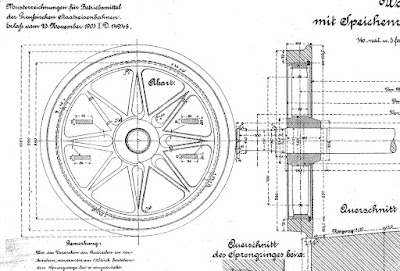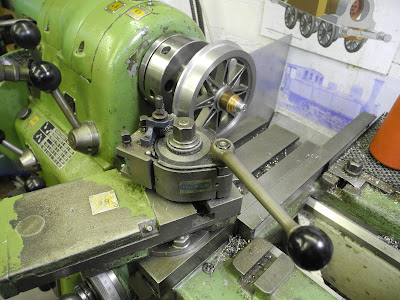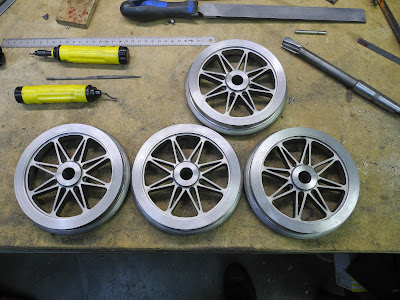The leaf springs are not a copy of the ones I made earlier for the open goods wagon (Omk) and the beer wagon (Bier Kühlwagen). This is because these wagons have stiffer springs so that a driver or passenger can actually sit on the wagon.
This Klappdeckelwagen is not suitable to sit on. Of course, the end stops on the lids are not very comfortable to sit on, but also the construction is not strong enough to take the weight of a person. Therefore different springs had to be made. Without going into the theory and mathematics of calculating springs, I simply used a practical way to determine the spring force.
The wagon will be used for some extra water, oil cans, the blower, and firing tools. I weighed these and this will be a load of approximately 15-17 kilograms. The superstructure was put on a scale and weighed 16 kilos. This is with a load of 16 kg. means that each spring will have to take approx. 8 kilograms.
With this value in mind, I made the leaf springs. Started with 9 blades (0.8 mm x 12 mm spring steel) and then added individual blades and tested the force it could withstand in comparison with the compression. This was done on a household scale.
The first leaves are the top blades (master leaf).
They have lugs at the end which connect them with shackles and a support bracket to the wagon frame.
To bend these lugs, the material had to be annealed.
Bending in the Gressel bending machine, but this can only bend for 180 degrees.
To make it a complete lug, the last bit was bent in the vice around a 4 mm piece of rod.
The roller bending machine was set to give the correct radius to the strip material.
The four completed top blades (master leaves).
The 'test load' on the scale
The wagon was loaded, to simulate the total maximum load.
All four springs were then put in position between the frame and axle boxes.

The deflection could now be tested, and extra blades were made and added to the complete set, to determine the needed stiffness of the complete leaf spring assembly.
A small 2 mm hole is drilled in each blade, so a bolt can keep them together.
The spring buckle was made of a 2 mm steel strip.
To make a nice square sharp bend possible, a groove was milled.
These grooves make it possible to get a sharp angle.
Even the 2 mm steel is a bit too thick for the bending machine, with the grooves it was possible to bend it.
A piece of strip is silver soldered on the U-shape, to make it a closed buckle.
The buckle acts as a central clamp that keeps the blades together.
A bit of extra length of this strip makes positioning easy during soldering,
and is removed afterward with a file.
On the top of the blades, a small locking strip is inserted in the buckle.
This will compress all the individual blades together in the buckle.
A 2 mm wide slot has to be cut in this strip, which was done with a hand saw.
I've inserted two saw blades together in the saw, so in one cut the slot was 2 mm wide.
The shackles are made from an old motorcycle chain.
Cross-drilling the 4 mm pins, for taking up the split pins. This simple drilling jig is used.
Half the part of the shackle.
All the parts for the shackles and their frame supports.
A small fixture for silver soldering the shackle supports.
The weight of the brass fixture keeps the bush in position during the soldering process.
After soldering, remove the support and insert parts for the next one.
Soldering with a fixture, assures good dimension accuracy and works fast.
(In one hour all eight supports were made).
Fixing the supports on the frame took a bit more time. This consists of disassembling the frame, drilling and tapping (M3), and then assembling everything.
The end caps of the axle boxes were 3D printed in stainless steel.
This photo shows them after printing, still on the building plate of the printer.
They are fixed with four M3 bolts.
The wheels are glued to the axles.
The leaf spring with shackles and supports on the wagon.
The wagon, fully sprung, on its wheels.
Steps and lamp irons are the last things to make, before starting the paint job.
The "Märklin train set" 😄 at the Voorjaarsstoomdag 24th of April 2022 in Waalre.
This model engineer exhibition was organized by our club Stoomgroep Zuid.























































